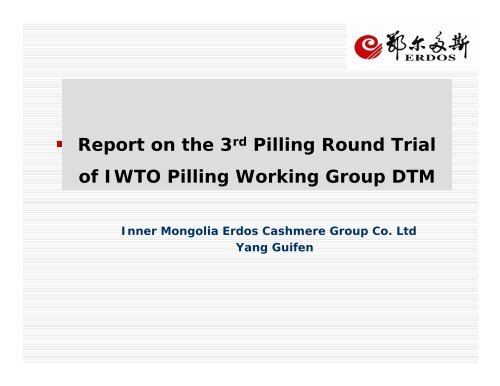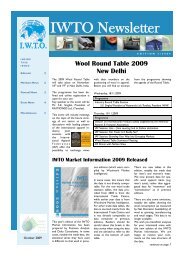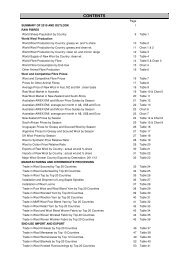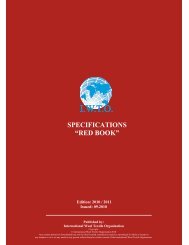Report on the 3rd Pilling Round Trial of IWTO Pilling Working Group ...
Report on the 3rd Pilling Round Trial of IWTO Pilling Working Group ...
Report on the 3rd Pilling Round Trial of IWTO Pilling Working Group ...
You also want an ePaper? Increase the reach of your titles
YUMPU automatically turns print PDFs into web optimized ePapers that Google loves.
扫描电子显微镜与光学显微镜鉴<br />
别山羊绒纤维的技术探讨<br />
<str<strong>on</strong>g>Report</str<strong>on</strong>g> <strong>on</strong> <strong>the</strong> 3 rd <strong>Pilling</strong> <strong>Round</strong> <strong>Trial</strong><br />
<strong>of</strong> <strong>IWTO</strong> <strong>Pilling</strong> <strong>Working</strong> <strong>Group</strong> DTM<br />
Inner M<strong>on</strong>golia Erdos Cashmere <strong>Group</strong> Co. Ltd<br />
Yang Guifen
<str<strong>on</strong>g>Report</str<strong>on</strong>g> <strong>on</strong> <strong>the</strong> <strong>3rd</strong> <strong>Pilling</strong> <strong>Round</strong> <strong>Trial</strong> <strong>of</strong> <strong>IWTO</strong><br />
<strong>Pilling</strong> <strong>Working</strong> <strong>Group</strong> DTM<br />
引言:<br />
Abstract<br />
� Indicative Summary to <strong>IWTO</strong> <strong>Pilling</strong> <strong>Round</strong> <strong>Trial</strong>s<br />
� Reas<strong>on</strong> Analysis <strong>on</strong> Factors Affecting Precisi<strong>on</strong> <strong>of</strong> <strong>the</strong><br />
Test Results in ICI <strong>Pilling</strong> Box Method<br />
� Recommendati<strong>on</strong>s
<str<strong>on</strong>g>Report</str<strong>on</strong>g> <strong>on</strong> <strong>the</strong> 3 rd <strong>Pilling</strong> <strong>Round</strong> <strong>Trial</strong> <strong>of</strong> <strong>IWTO</strong><br />
<strong>Pilling</strong> <strong>Working</strong> <strong>Group</strong> DTM<br />
� Brief Introducti<strong>on</strong> to <strong>IWTO</strong> <strong>Pilling</strong> <strong>Round</strong> <strong>Trial</strong>s<br />
Altoge<strong>the</strong>r 3 <strong>IWTO</strong> Internati<strong>on</strong>al <strong>Pilling</strong> <strong>Round</strong> <strong>Trial</strong>s were organized so<br />
far, <strong>the</strong> 1 st <strong>on</strong>e was carried out according to <strong>the</strong> <strong>Working</strong> <strong>Group</strong> Draft<br />
in 2006/07 organized by <strong>IWTO</strong> <strong>Pilling</strong> <strong>Working</strong> <strong>Group</strong>. 12 laboratories<br />
participated in that round trial, <strong>the</strong> detailed results and analysis were<br />
reported to <strong>IWTO</strong> Edinburgh C<strong>on</strong>gress in 2007 by <strong>Working</strong> <strong>Group</strong><br />
members. In <strong>the</strong> following 3 years <strong>the</strong>reafter, working group members<br />
have always been researching <strong>the</strong> different affecting elements that<br />
leads to scattered testing data and trying to find soluti<strong>on</strong>s. The<br />
<strong>Working</strong> <strong>Group</strong> Draft was modified several times afterwards. The 2 nd<br />
<strong>IWTO</strong> <strong>Pilling</strong> <strong>Round</strong> <strong>Trial</strong> was carried out in 2009/10 based <strong>on</strong><br />
preparati<strong>on</strong> works made by <strong>IWTO</strong> <strong>Pilling</strong> Work <strong>Group</strong>. The 3 rd is<br />
organized in 2010/11 after pilling Photograph Standards were<br />
developed by China Inner M<strong>on</strong>golia Erdos Cashmere <strong>Group</strong>. The<br />
2010.05 versi<strong>on</strong> <strong>of</strong> <strong>the</strong> <strong>Pilling</strong> DTM was modified according to test<br />
results <strong>of</strong> The 3 rd <strong>IWTO</strong> <strong>Pilling</strong> <strong>Round</strong> <strong>Trial</strong>, which results in <strong>the</strong> 2011.05<br />
Versi<strong>on</strong> <strong>of</strong> <strong>Working</strong> <strong>Group</strong> DTM.
<str<strong>on</strong>g>Report</str<strong>on</strong>g> <strong>on</strong> <strong>the</strong> 3 rd <strong>Pilling</strong> <strong>Round</strong> <strong>Trial</strong> <strong>of</strong> <strong>IWTO</strong><br />
<strong>Pilling</strong> <strong>Working</strong> <strong>Group</strong> DTM<br />
� Samples and Tests <strong>of</strong> <strong>the</strong> 3 rd <strong>Round</strong> <strong>Trial</strong><br />
Total 12 knitted fabrics were supplied to each <strong>of</strong> <strong>the</strong> 6<br />
participating laboratories. 6 out <strong>of</strong> <strong>the</strong> 12 samples are 100%<br />
wool or wool blended and <strong>the</strong> o<strong>the</strong>r 6 100% cashmere fabrics,<br />
3 worsted and <strong>the</strong> o<strong>the</strong>r 3 woolen fabrics in each group,<br />
representing high, medium and low pilling propensity levels<br />
respectively. Each laboratory was supplied with a copy <strong>of</strong> 2010<br />
Versi<strong>on</strong> <strong>of</strong> <strong>IWTO</strong> <strong>Pilling</strong> <strong>Working</strong> <strong>Group</strong> DTM, toge<strong>the</strong>r with a<br />
copy <strong>of</strong> Instructi<strong>on</strong>s to <strong>the</strong> <strong>Round</strong> <strong>Trial</strong> to carry out <strong>the</strong> tests.
<str<strong>on</strong>g>Report</str<strong>on</strong>g> <strong>on</strong> <strong>the</strong> 3 rd <strong>Pilling</strong> <strong>Round</strong> <strong>Trial</strong> <strong>of</strong> <strong>IWTO</strong><br />
<strong>Pilling</strong> <strong>Working</strong> <strong>Group</strong> DTM<br />
� Experiment Design<br />
Each sample is required to be tested twice both at 2 and 3<br />
hours or2 and 4 hours corresp<strong>on</strong>dingly(3-hour test for pure<br />
cashmere fabrics and 4-hour test for wool or cashmere/wool<br />
blended fabrics). <strong>Pilling</strong> c<strong>on</strong>diti<strong>on</strong>s <strong>of</strong> cashmere and cashmere<br />
blended fabric specimens are assessed by comparing with<br />
<strong>Pilling</strong> Photographic Standard for Cashmere Knitted Fabrics;<br />
<strong>Pilling</strong> grades <strong>of</strong> pure wool fabrics are assessed by comparing<br />
with Photographic Standard: SM54 Lambswool.
95% C<strong>on</strong>fidence Interval<br />
<str<strong>on</strong>g>Report</str<strong>on</strong>g> <strong>on</strong> <strong>the</strong> 3 rd <strong>Pilling</strong> <strong>Round</strong> <strong>Trial</strong> <strong>of</strong> <strong>IWTO</strong><br />
<strong>Pilling</strong> <strong>Working</strong> <strong>Group</strong> DTM<br />
� Relati<strong>on</strong>ship between C<strong>on</strong>fidence Limit<br />
and <strong>Pilling</strong> Grade from <strong>the</strong> <strong>Round</strong> <strong>Trial</strong><br />
2.5<br />
2<br />
1.5<br />
1<br />
Combined Ratings<br />
y = -0.5126x2 + 2.6812x - 1.4438<br />
R2 0.5<br />
0<br />
= 0.5075<br />
1 1.5 2 2.5 3<br />
Mean Rating<br />
3.5 4 4.5 5<br />
Figure 1. Relati<strong>on</strong>ship between<br />
C<strong>on</strong>fidence Limit and <strong>Pilling</strong><br />
Grades in 2006/07 <strong>Round</strong> <strong>Trial</strong><br />
95% C<strong>on</strong>fidence Limits<br />
2<br />
1.5<br />
1<br />
0.5<br />
0<br />
y = -0.2727x 2 + 1.5487x - 0.8475<br />
R 2 = 0.7154<br />
0 0.5 1 1.5 2 2.5 3 3.5 4 4.5 5<br />
Mean <strong>Pilling</strong> Grade<br />
Figure 2. Relati<strong>on</strong>ship between<br />
C<strong>on</strong>fidence Limit and <strong>Pilling</strong><br />
Grades in 2009/10 <strong>Round</strong> <strong>Trial</strong>
<str<strong>on</strong>g>Report</str<strong>on</strong>g> <strong>on</strong> <strong>the</strong> 3 rd <strong>Pilling</strong> <strong>Round</strong> <strong>Trial</strong> <strong>of</strong> <strong>IWTO</strong><br />
<strong>Pilling</strong> <strong>Working</strong> <strong>Group</strong> DTM<br />
� An obvious relati<strong>on</strong>ship exists between C<strong>on</strong>fidence Limit and<br />
pilling grade, which basically is that testing precisi<strong>on</strong> is high<br />
when pilling grades are extremely high or extremely low;<br />
testing precisi<strong>on</strong> is low when pilling grades are between 2~3.5<br />
Grade.<br />
95%C<strong>on</strong>fidence Limite<br />
1.5<br />
1.0<br />
y = -0.2023x 2 + 1.0225x - 0.2413<br />
R 2 0.5<br />
0.0<br />
= 0.5894<br />
0.0 1.0 2.0 3.0 4.0 5.0<br />
Mean <strong>Pilling</strong> grade<br />
Figure 3. Relati<strong>on</strong>ship between C<strong>on</strong>fidence<br />
Limit and <strong>Pilling</strong> Grades in 2010/11 <strong>Round</strong> <strong>Trial</strong>
<str<strong>on</strong>g>Report</str<strong>on</strong>g> <strong>on</strong> <strong>the</strong> 3 rd <strong>Pilling</strong> <strong>Round</strong> <strong>Trial</strong> <strong>of</strong> <strong>IWTO</strong><br />
<strong>Pilling</strong> <strong>Working</strong> <strong>Group</strong> DTM<br />
� Precisi<strong>on</strong> value <strong>of</strong> 2010/11 <strong>Round</strong> <strong>Trial</strong> is shown in<br />
<strong>the</strong> following Table 1.<br />
Mean Grade<br />
1.0<br />
1.5<br />
2.0<br />
2.5<br />
3.0<br />
3.5<br />
4.0<br />
4.5<br />
Within-Laboratory<br />
Variance<br />
0.002<br />
0.035<br />
.0.053<br />
0.003<br />
0.057<br />
0.065<br />
0.039<br />
0.022<br />
Between-Laboratory<br />
Variance<br />
0.056<br />
0.154<br />
0.329<br />
0.306<br />
0.207<br />
0.149<br />
0.063<br />
0.11<br />
95%C<strong>on</strong>fidence<br />
Limit<br />
0.5<br />
0.8<br />
1.0<br />
1.0<br />
1.0<br />
0.9<br />
0.6<br />
0.5
<str<strong>on</strong>g>Report</str<strong>on</strong>g> <strong>on</strong> <strong>the</strong> 3 rd <strong>Pilling</strong> <strong>Round</strong> <strong>Trial</strong> <strong>of</strong> <strong>IWTO</strong><br />
<strong>Pilling</strong> <strong>Working</strong> <strong>Group</strong> DTM<br />
� Reas<strong>on</strong> Analysis <strong>on</strong> Factors which will influence <strong>on</strong><br />
Precisi<strong>on</strong> <strong>of</strong> Test Results in ICI <strong>Pilling</strong> Box Method<br />
� Precisi<strong>on</strong> <strong>of</strong> a test method includes both precisi<strong>on</strong> under<br />
repeatability c<strong>on</strong>diti<strong>on</strong>s and precisi<strong>on</strong> under reproducibility<br />
c<strong>on</strong>diti<strong>on</strong>s. It’s seen from test results <strong>of</strong> several <strong>Pilling</strong> <strong>Round</strong><br />
<strong>Trial</strong>s and statistical results in Table 1 that this test method<br />
shows a good repeatability but comparatively bad<br />
reproducibility when pilling grade lies between grade 3.5~<br />
grade 2.
<str<strong>on</strong>g>Report</str<strong>on</strong>g> <strong>on</strong> <strong>the</strong> 3 rd <strong>Pilling</strong> <strong>Round</strong> <strong>Trial</strong> <strong>of</strong> <strong>IWTO</strong><br />
<strong>Pilling</strong> <strong>Working</strong> <strong>Group</strong> DTM<br />
� Reas<strong>on</strong> Analysis <strong>on</strong> Low Reproducibility<br />
� C<strong>on</strong>siderable works have been d<strong>on</strong>e by <strong>IWTO</strong> <strong>Pilling</strong> <strong>Working</strong> <strong>Group</strong><br />
members after <strong>the</strong> 1 st and <strong>the</strong> 2 nd <strong>Round</strong> <strong>Trial</strong>s, trying to figure out<br />
whe<strong>the</strong>r <strong>the</strong> pilling tester or pilling rating plays greater influence <strong>on</strong> test<br />
result differences, including carried out comparis<strong>on</strong> analysis tests <strong>on</strong><br />
two different types <strong>of</strong> cork linings and polyurethane tubes comm<strong>on</strong>ly<br />
used in various labs; Requiring laboratory that exhibited significant<br />
differences <strong>on</strong> pilling grades to evaluate tested specimens from o<strong>the</strong>r<br />
participating labs; sent all tested specimens in total 12 labs to <strong>on</strong>e<br />
specific lab which organized <strong>the</strong> round trial for rating etc.. Finally, it’s<br />
found that differences <strong>on</strong> pilling grade in different labs are mutually<br />
caused by both pilling tester and pilling rating.
<str<strong>on</strong>g>Report</str<strong>on</strong>g> <strong>on</strong> <strong>the</strong> 3 rd <strong>Pilling</strong> <strong>Round</strong> <strong>Trial</strong> <strong>of</strong> <strong>IWTO</strong><br />
<strong>Pilling</strong> <strong>Working</strong> <strong>Group</strong> DTM<br />
<strong>Pilling</strong> Tester elements affects test results in <strong>the</strong> following 2<br />
ways:<br />
1) Polyurethane tubes produced by different manufacturers will have<br />
significant influence <strong>on</strong> test result.<br />
2) Cork linings which are initially put into use or come to <strong>the</strong> end <strong>of</strong> its<br />
service life will have significant influence <strong>on</strong> test result.<br />
<strong>Pilling</strong> Grade Evaluati<strong>on</strong> will affect test result from <strong>the</strong><br />
following 2 points:<br />
1) <strong>Pilling</strong> grade evaluators in different testing laboratories formed <strong>the</strong>ir<br />
own particular assessment criteria for a l<strong>on</strong>g time, so <strong>the</strong>y will give<br />
more c<strong>on</strong>sistent pilling grades to a whole set <strong>of</strong> tested specimens but<br />
larger variati<strong>on</strong> to <strong>the</strong> pilling grade <strong>of</strong> a single tested specimen.
<str<strong>on</strong>g>Report</str<strong>on</strong>g> <strong>on</strong> <strong>the</strong> 3 rd <strong>Pilling</strong> <strong>Round</strong> <strong>Trial</strong> <strong>of</strong> <strong>IWTO</strong><br />
<strong>Pilling</strong> <strong>Working</strong> <strong>Group</strong> DTM<br />
For example, Laboratories No. 7 and 9 (labs that exhibited a<br />
significant difference in reported results) rated 3 full sets <strong>of</strong> tested<br />
specimens from o<strong>the</strong>r laboratories after 2009/10 <strong>Round</strong> <strong>Trial</strong>, Mean<br />
grade values are shown in Figure 4.<br />
Rating<br />
5<br />
4.5<br />
4<br />
3.5<br />
3<br />
2.5<br />
2<br />
1.5<br />
1<br />
0.5<br />
0<br />
Mean <strong>of</strong> all fabrics<br />
1 2<br />
Hours<br />
Figure 4 Mean Grade Rated by 2 Labs to Specimens Tested in 3 O<strong>the</strong>r Labs<br />
Wherein:Abscissa 1 = 2hrs test 2 = 4hrs test<br />
Lab 9<br />
Lab 7
<str<strong>on</strong>g>Report</str<strong>on</strong>g> <strong>on</strong> <strong>the</strong> 3 rd <strong>Pilling</strong> <strong>Round</strong> <strong>Trial</strong> <strong>of</strong> <strong>IWTO</strong><br />
<strong>Pilling</strong> <strong>Working</strong> <strong>Group</strong> DTM<br />
<strong>Pilling</strong> Grade<br />
Ano<strong>the</strong>r example: <strong>on</strong>e laboratory gave significant lower test results to all<br />
samples in <strong>the</strong> 2 round trials than all o<strong>the</strong>r labs. A specific laboratory was<br />
selected to carry out ratings <strong>on</strong> specimens tested in o<strong>the</strong>r laboratories to<br />
investigate whe<strong>the</strong>r such differences are caused by pilling tester or by<br />
pilling grade evaluati<strong>on</strong>. It’s seen from Figure 5and 6 that Laboratory No.<br />
2 gave generally lower grades to all samples than o<strong>the</strong>r labs.<br />
5<br />
4<br />
3<br />
2<br />
1<br />
0<br />
c1 c2 c3 c4 c5 c6 w1 w2 w3 w4 w5 w6<br />
Samples<br />
Lab 1<br />
Lab 2<br />
Lab 3<br />
Lab 4<br />
Lab 5<br />
Lab 6<br />
Figure 5 Test Results <strong>of</strong> All Participating Labs<br />
in 2010/11 <strong>Round</strong> <strong>Trial</strong><br />
Mean <strong>Pilling</strong> Grade<br />
4.0<br />
3.5<br />
3.0<br />
2.5<br />
2.0<br />
1.5<br />
1.0<br />
0.5<br />
0.0<br />
2hr 3hr<br />
Testing time<br />
4hr<br />
Lab 1<br />
Lab 2<br />
Lab 3<br />
Lab 4<br />
Lab 5<br />
Lab 6<br />
Figure 6 Mean grade <strong>of</strong> all participating labs<br />
in 2010/11 <strong>Round</strong> <strong>Trial</strong>
<str<strong>on</strong>g>Report</str<strong>on</strong>g> <strong>on</strong> <strong>the</strong> 3 rd <strong>Pilling</strong> <strong>Round</strong> <strong>Trial</strong> <strong>of</strong> <strong>IWTO</strong><br />
<strong>Pilling</strong> <strong>Working</strong> <strong>Group</strong> DTM<br />
� Ratings given by Lab A to specimens tested in o<strong>the</strong>r 3 labs are shown in<br />
<strong>the</strong> following Figure 7. It’s seen from Figure 7 that pilling grades rated<br />
to tested specimens <strong>of</strong> Lab 2 lie between those rated to Lab 3 and Lab<br />
4, which means pilling raters in Lab 2 have stricter visual criteria <strong>on</strong><br />
pilling grade rating.<br />
Rating<br />
5<br />
4<br />
3<br />
2<br />
1<br />
0<br />
c1 c2 c3 c4 c5 c6 w1 w2 w3 w4 w5 w6<br />
Tested Samples<br />
Lab 2<br />
Lab 3<br />
Lab 4<br />
Figure 7. Ratings Given by Lab A to samples Tested in<br />
o<strong>the</strong>r 3 different labs
<str<strong>on</strong>g>Report</str<strong>on</strong>g> <strong>on</strong> <strong>the</strong> 3 rd <strong>Pilling</strong> <strong>Round</strong> <strong>Trial</strong> <strong>of</strong> <strong>IWTO</strong><br />
<strong>Pilling</strong> <strong>Working</strong> <strong>Group</strong> DTM<br />
2) Photographic Standard used in <strong>the</strong> 2 previous round trials does not<br />
c<strong>on</strong>form to <strong>the</strong> actual pilling c<strong>on</strong>diti<strong>on</strong>s <strong>of</strong> tested samples, so little<br />
reference effects can be relied <strong>on</strong>, pilling raters in different participating<br />
labs assessed <strong>the</strong> pilling grades mainly according to <strong>the</strong>ir own<br />
experiences, which showed greater subjective influence <strong>on</strong> <strong>the</strong> test<br />
results.<br />
In order to know whe<strong>the</strong>r <strong>the</strong>re is any large difference <strong>on</strong> test results to <strong>the</strong><br />
same set <strong>of</strong> samples by ICI <strong>Pilling</strong> Box Method during l<strong>on</strong>g time interval,<br />
<strong>the</strong> same set <strong>of</strong> samples are used in <strong>the</strong> 2 <strong>Pilling</strong> <strong>Round</strong> <strong>Trial</strong>s (same<br />
batch <strong>of</strong> yarn is used with <strong>the</strong> same cover factor and finishing<br />
procedures).
<str<strong>on</strong>g>Report</str<strong>on</strong>g> <strong>on</strong> <strong>the</strong> 3 rd <strong>Pilling</strong> <strong>Round</strong> <strong>Trial</strong> <strong>of</strong> <strong>IWTO</strong><br />
<strong>Pilling</strong> <strong>Working</strong> <strong>Group</strong> DTM<br />
Results <strong>of</strong> 2 hours test in 2009/10 round trial is 0.5 grade more or less different from<br />
those in 2010/11 round trial except those <strong>of</strong> sample W2 and W3. It’s believed after<br />
analysis, that test results <strong>of</strong> sample W2 are mainly affected by <strong>Pilling</strong> Photographic<br />
Standard (<strong>the</strong> Photographic Standard affiliated to ASTM D 3512 is used in 2009/10<br />
round trial, while SM54 Lambswool is used in 2010/11 round trial). Differences <strong>on</strong><br />
test results <strong>of</strong> sample W3 between <strong>the</strong>se 2 round trials are affected by both sample<br />
preparati<strong>on</strong> and <strong>Pilling</strong> Photographic Standard. <strong>Pilling</strong> grades <strong>of</strong> sample W1 and W2<br />
after 4 hours test in 2010/11 is 1 grade lower than those in 2009/10 trial, that’s<br />
mainly affected by <strong>Pilling</strong> Photographic Standard. It’s seen from reported data that<br />
Chinese labs gave significantly different pilling grades to samples W1 and W2 from<br />
those given by labs out <strong>of</strong> China. So It is decided that <strong>the</strong> <strong>Pilling</strong> Photograph<br />
Standards developed by <strong>Pilling</strong> <strong>Working</strong> <strong>Group</strong> is adopted in this standard.
<str<strong>on</strong>g>Report</str<strong>on</strong>g> <strong>on</strong> <strong>the</strong> 3 rd <strong>Pilling</strong> <strong>Round</strong> <strong>Trial</strong> <strong>of</strong> <strong>IWTO</strong><br />
<strong>Pilling</strong> <strong>Working</strong> <strong>Group</strong> DTM<br />
� Recommendati<strong>on</strong>s<br />
It’s seen from results <strong>of</strong> <strong>the</strong> 3 <strong>Pilling</strong> <strong>Round</strong> <strong>Trial</strong>s that precisi<strong>on</strong> <strong>of</strong><br />
<strong>the</strong> pilling test method fundamentally reaches to a reas<strong>on</strong>able<br />
level under <strong>the</strong> active works <strong>of</strong> <strong>the</strong> <strong>IWTO</strong> <strong>Pilling</strong> <strong>Working</strong> <strong>Group</strong>.<br />
It’s recommended that this <strong>Working</strong> <strong>Group</strong> Draft to be<br />
upgraded to Draft Test Method in efforts to fur<strong>the</strong>r tackle <strong>the</strong><br />
following issues:
<str<strong>on</strong>g>Report</str<strong>on</strong>g> <strong>on</strong> <strong>the</strong> 3 rd <strong>Pilling</strong> <strong>Round</strong> <strong>Trial</strong> <strong>of</strong> <strong>IWTO</strong><br />
<strong>Pilling</strong> <strong>Working</strong> <strong>Group</strong> DTM<br />
1) <strong>Pilling</strong> rating relies significantly <strong>on</strong> subjective assessment <strong>of</strong> <strong>the</strong><br />
operators. No internati<strong>on</strong>al round trials <strong>on</strong> pilling are organized by any<br />
institute or organizati<strong>on</strong>. Each lab has its own pilling assessment style<br />
and evaluati<strong>on</strong> criteria. This is a very important reas<strong>on</strong> <strong>of</strong> low<br />
reproducibility <strong>on</strong> test results <strong>of</strong> ICI <strong>Pilling</strong> Box Method. It’s<br />
recommended that more pilling round trials are organized am<strong>on</strong>g<br />
internati<strong>on</strong>al laboratories after <strong>the</strong> implementati<strong>on</strong> <strong>of</strong> <strong>IWTO</strong> <strong>Pilling</strong><br />
Draft Test Method. Like those round trials identifying cashmere wool<br />
fibers, from which pilling rating orientati<strong>on</strong> may gradually be unified so<br />
that can greatly improve reproducibility <strong>of</strong> test results.
<str<strong>on</strong>g>Report</str<strong>on</strong>g> <strong>on</strong> <strong>the</strong> 3 rd <strong>Pilling</strong> <strong>Round</strong> <strong>Trial</strong> <strong>of</strong> <strong>IWTO</strong><br />
<strong>Pilling</strong> <strong>Working</strong> <strong>Group</strong> DTM<br />
2) Calibrati<strong>on</strong> procedures to cork lining and polyurethane tube are<br />
stipulated in detail in <strong>IWTO</strong> <strong>Pilling</strong> <strong>Working</strong> <strong>Group</strong> Draft Test Method,<br />
which is significant different from ISO or o<strong>the</strong>r countries’ ICI <strong>Pilling</strong> Box<br />
Method, but laboratories will not strictly follow such stipulati<strong>on</strong>s<br />
because this <strong>Working</strong> <strong>Group</strong> DTM is not a valid standard <strong>on</strong> current<br />
stage. Precisi<strong>on</strong> <strong>of</strong> test results between laboratories will be highly<br />
improved after this test method is implemented.
Thanks for your time and c<strong>on</strong>cerns
















